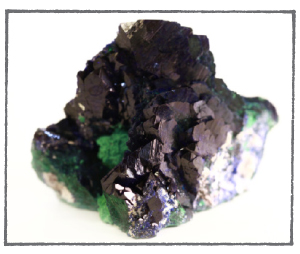AZURITE

A COPPER CARBONATE HYDROXIDE, azurite is named for its beautiful deep blue color. Formed in copper deposits, it can display more than 150 different types of facial crystal formations (faces), and it is often found intermixed with malachite (where it is referred to as azurmalachite). One of the most interesting varieties of this stone exhibits small bladed crystals and is mined in Chessy-les-Mines, France. Their often vitreous luster can make the specimens look like short crows’ feathers, and the finest of these examples were commonly used for ornamental purposes. They continue to be popular additions to personal mineral collections. Very practically, the stone has been used as a pigment in both paintings and manuscripts since the fifteenth century, and it was also mined in ancient Egypt and is believed to form the base of blue glazes used at that time.
Gem therapy practitioners use the stone extensively to facilitate inner vision, and it is believed to be a powerful talisman against psychic harm. It is thought to heighten one’s ability to focus on a task and retain information. Practitioners believe that azurite heals all issues pertaining to the head and can be especially helpful in relieving the pain of migraine headaches.